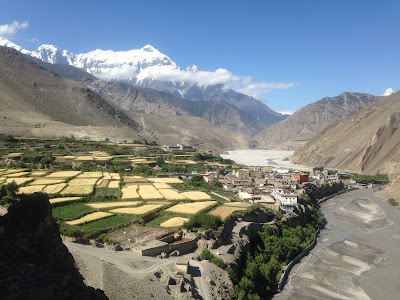Translocated rhino gives birth to male calf
Translocated rhino gives birth to male calf
A rhino which was trans located to
the Bardiya National Park (BNP) from the Chitwan National Park (CNP) in March
has given birth to male calf. The rhino with ID 21010 gave birth to a male calf
in the Guthi post area on Sunday, said Ashok Bhandari, assistant chief warden
of the BNP. “The calf is healthy. The mother was one of the five rhinos
translocated to Babai Valley of the BNP.The Department of National Parks and
Wildlife Conservation (DNPWC), with the support from WWF Nepal, had
translocated the rhinos as part of a plan to protect the endangered species and
increase their number in potential habitats across the country. The DNPWC plans
to move 30 rhinos to different habitats by 2018.
This is, however, not the first time a translocated rhino has given birth in Bardiya. Earlier, between 1986--when first rhino translocation took place--and 2000, a total of 27 calves were born in Bardiya. Thirteen of these endangered species were brought to the BNP from the CNP in 1986.By 2003, a total of 87 rhinos were translocated to the BNP and Shuklaphanta Wildlife Reserve, and over 70 rhinos were moved to Babai Valley.
Babai Valley that was once considered an ideal habitat for tigers and rhinos given the huge expanse of forest cover and grassland and limited human disturbance, however, gained notoriety for poaching, particularly between 2002 and 2006 when insurgency was at its peak. Almost all the rhinos that were translocated between 1986 and 2003 were wiped out.
But in recent years, conservation efforts with increased participation of government bodies, conservation partners, security forces and communities, Babai Valley’s habitats are gradually reviving. We have witnessed considerable increase in tiger and rhino population in and around the Babai flood plain areas, Bhandari said. “The birth of a male calf from a translocated rhino is encouraging. Nepal is home to 645 one-horned rhinos, with the CNP having the highest number of rhinos at 605 followed by the BNP at 29.
This is, however, not the first time a translocated rhino has given birth in Bardiya. Earlier, between 1986--when first rhino translocation took place--and 2000, a total of 27 calves were born in Bardiya. Thirteen of these endangered species were brought to the BNP from the CNP in 1986.By 2003, a total of 87 rhinos were translocated to the BNP and Shuklaphanta Wildlife Reserve, and over 70 rhinos were moved to Babai Valley.
Babai Valley that was once considered an ideal habitat for tigers and rhinos given the huge expanse of forest cover and grassland and limited human disturbance, however, gained notoriety for poaching, particularly between 2002 and 2006 when insurgency was at its peak. Almost all the rhinos that were translocated between 1986 and 2003 were wiped out.
But in recent years, conservation efforts with increased participation of government bodies, conservation partners, security forces and communities, Babai Valley’s habitats are gradually reviving. We have witnessed considerable increase in tiger and rhino population in and around the Babai flood plain areas, Bhandari said. “The birth of a male calf from a translocated rhino is encouraging. Nepal is home to 645 one-horned rhinos, with the CNP having the highest number of rhinos at 605 followed by the BNP at 29.
source by Kathmandu post



Comments
Post a Comment